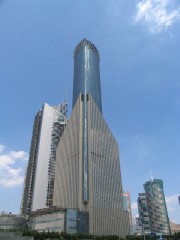Interesting Facts about Shanghai
Locations Trivia This Chinese coastal city has its infamous roots in the First Opium War dating to 1812 when China suffered defeat and was forced to open several ports for trade with the outer world. Although Shanghai’s past is steeped in notorious back alleys and nefarious characters plodding kidnappings and the like, Shanghai has come a long way to become what it is known as today-the Paris of the Orient.
This Chinese coastal city has its infamous roots in the First Opium War dating to 1812 when China suffered defeat and was forced to open several ports for trade with the outer world. Although Shanghai’s past is steeped in notorious back alleys and nefarious characters plodding kidnappings and the like, Shanghai has come a long way to become what it is known as today-the Paris of the Orient.
Shanghai was one of five treaty ports the British forced the Chinese to open. The others were Canton, Amoy (Ziamen), Ningbo and Fuzhou.
While the British established a settlement in a section of Shanghai, the French and Americans also established their own settlements. But Shanghai quickly became a destination for émigrés from Russia, Japan, and others from Europe and Western Asia.
Today the streets of the French Concession and Foreign Settlement have changed to become well-to-do neon-lit avenues. Many would like the government to do more to preserve this historic area of Shanghai.
One place to revisit much of the city’s past is at the Shanghai Municipal History Museum devoted to preserving relics of the city’s foreign period.
Historians trace Shangai’s earliest beginnings to a wall built around its vicinity in 1553 AD to protect the people from marauding Japanese pirates. Until the nineteenth century and the First Opium War, it was considered as essentially a fishing village.
The casinos and brothels under the authority of gangsters sprouted up as trade began to make Shanghai one of the busiest centers in the East.
The Bund is a major site to see in Shanghai. This stretch of buildings represents the historic western influence that dominated so much of the city’s history. One of the Bund’s most famous buildings is the former Hongkong and Shanghai Bank building.
Dr. Sun Yat-Sen’s Former Residence is located in the French Concession on the former Rue Moliere. Today it can be visited though the street name is now known as Xiangshan Road.
World War II marked Shanghai as a destination for refugees; it was the only city where Jews were welcomed without condition.
The Jewish Refugee Museum was reopened in 1992 and is dedicated to the Jews who were forced to leave their home lands and occupations to live in poverty in the Chinese city.
During Mao’s rule and after, Shanghai was heavily taxed by the government and many of the city’s upper class and educated people were purged from the city.
The famous Nanking Road lies in Shanghai’s Huangpu District where the city hall and other important government centers are located.
Today Shanghai is one China’s most important cultural, economic and financial centers.
In 2005 Shanghai was termed the world’s largest port for cargo.
While there are hundreds of wonderful sites for tourists to visit today, many plan a trip to the Dajung Pavilion which is the only surviving section of the Ming Dynasty wall that once encircled the city.
The Longhua Temple and Pavilion represents a beloved Chinese site outside the old city.
Other noteworthy sites to visit include: Wenmiao Confucian Temple, Jade Buddha Temple, Oriental Pearl TV Tower, Chairman Mao’s Residence, The Old Town, Hunxinting Teahouse, Yu Garden, Shanghai Arts and Crafts Museum, Shikumen Open House, Sanshan Guild-Hall, Shanghai Exhibition Center, etc…Of course, Shanghai’s various districts contain memorable sites making the city one of the great destinations of travel.
